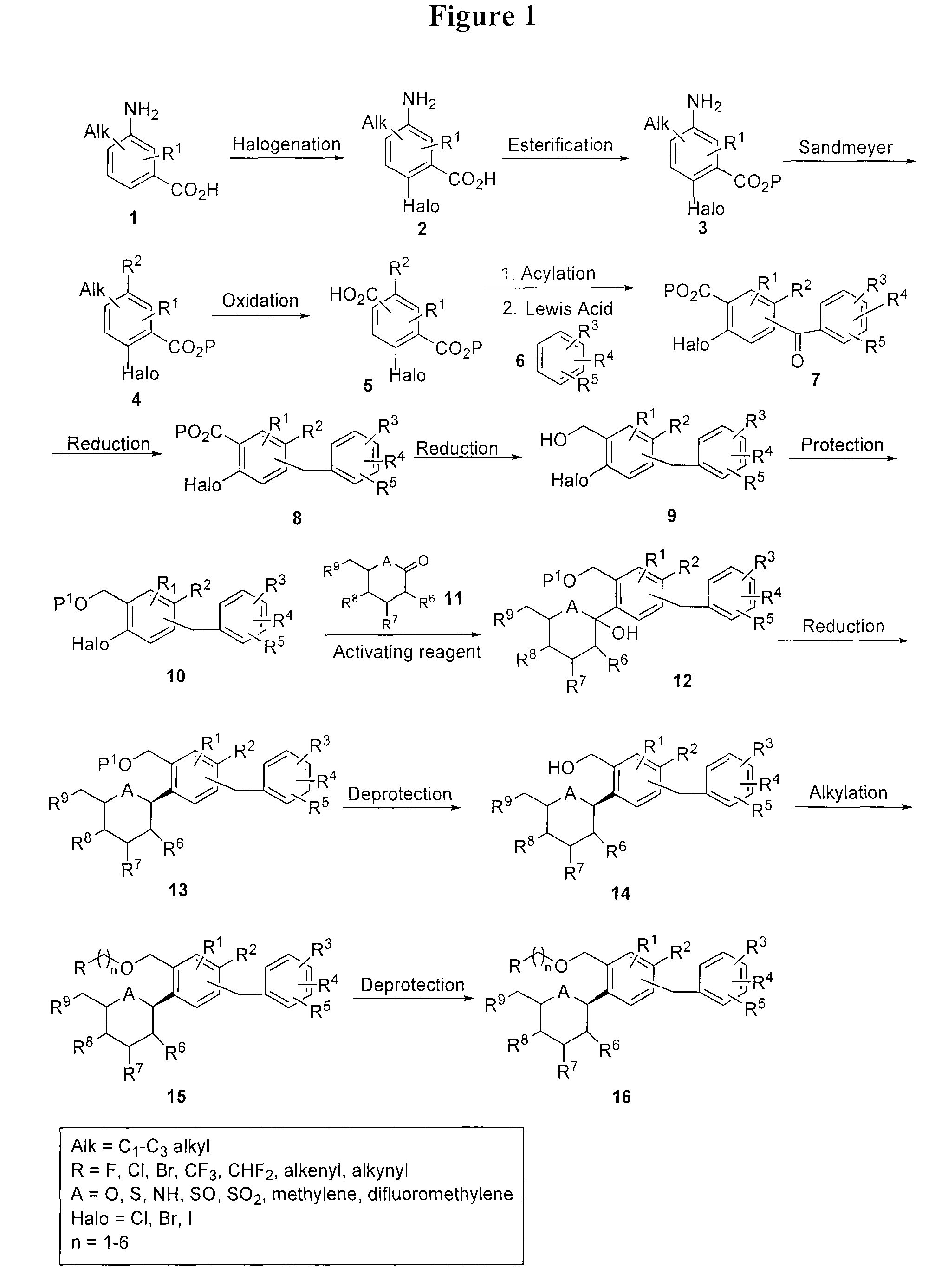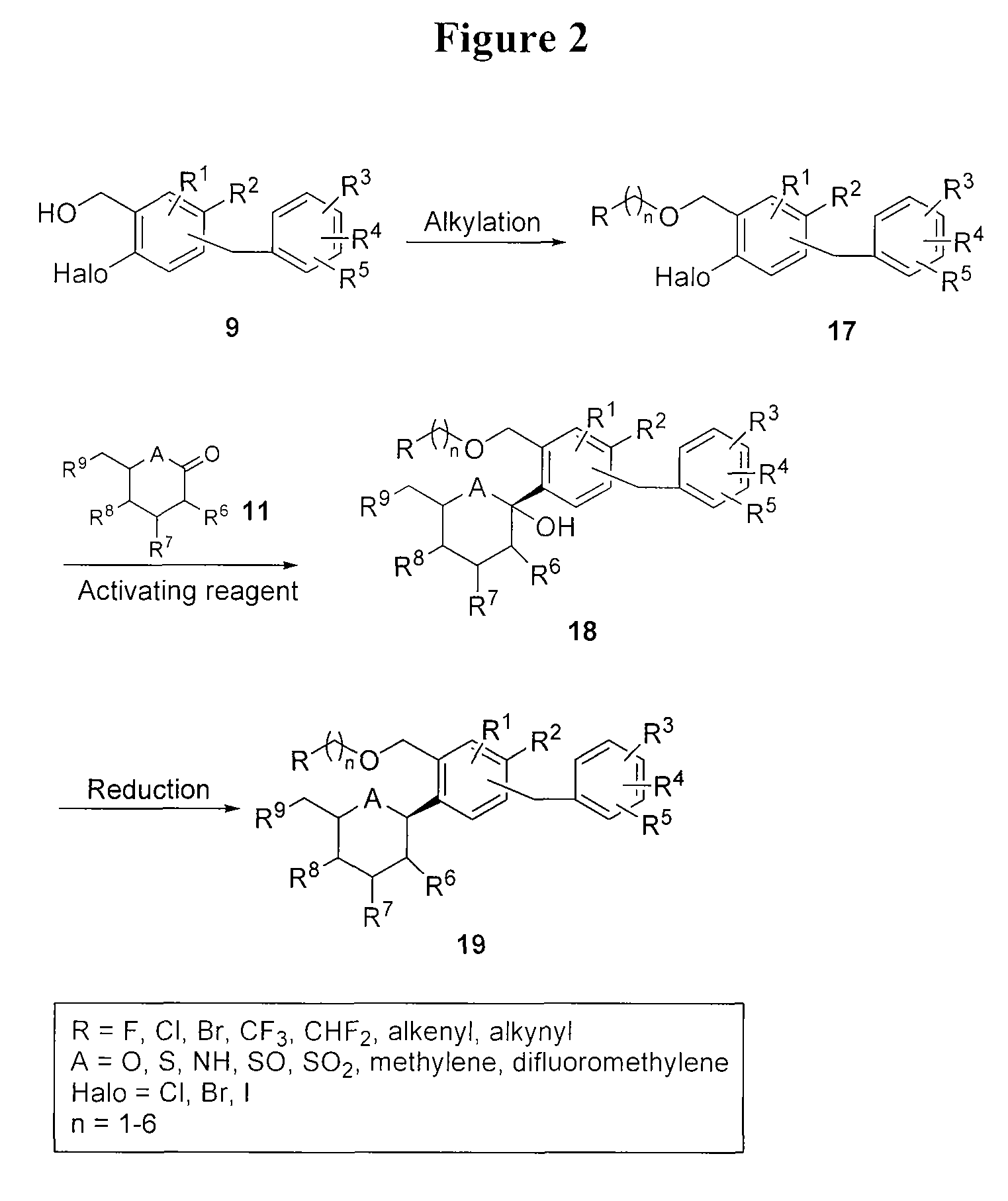Benzylic glycoside derivatives and methods of use
a technology of benzylic glycoside and derivatives, which is applied in the direction of peptide/protein ingredients, metabolism disorders, extracellular fluid disorders, etc., can solve the problems of undesired side effects and insufficient glycemic control
- Summary
- Abstract
- Description
- Claims
- Application Information
AI Technical Summary
Benefits of technology
Problems solved by technology
Method used
Image
Examples
example 1
[0182]This example illustrates the preparation of compound I according to the approach provided in FIG. 9. The general method is applicable to other compounds of the present invention.
Preparation of 5-amino-2-bromo-4-methylbenzoic acid (Intermediate A)
[0183]
[0184]To a cooled solution (5° C.) of 3-amino-4-methylbenzoic acid (412.2 g, 2.72 mole) in DMF (2.2 L) was added N-bromosuccinimide (495.1 g, 2.78 mole) in small portions at such a rate that the reaction mixture temperature was kept below 15° C. After being stirred for one hour, the reaction mixture was poured onto ice water (1.2 L) with stirring. The solid that formed was filtered, and the filter cake was washed with ice water (3×2 L) and then dried at 60° C. to give a pink solid. Yield: 546 g (87%). 1H-NMR (DMSO-d6, 300 MHz): δ 7.20 (s, 1H), 7.04 (s, 1H), 2.05 (s, 3H).
Preparation of methyl 5-amino-2-bromo-4-methylbenzoate (Intermediate B)
[0185]
[0186]To a cooled solution (5° C.) of 5-amino-2-bromo-4-methylbenzoic acid (100.0 g, ...
example 2
Preparation of 1-(5-chloro-4-(4-ethylbenzyl)-2-((2S,3R,4R,5S,6R)-3,4,5-trihydroxy-6-(hydroxymethyl)tetrahydro-2H-pyran-2-yl)benzyloxy)propan-2-one (Compound K)
[0206]
[0207]To a stirred solution of (2R,3R,4R,5S,6S)-2-(acetoxymethyl)-6-(4-chloro-5-(4-ethylbenzyl)-2-((2-oxopropoxy)methyl)phenyl)tetrahydro-2H-pyran-3,4,5-triyl triacetate (36.8 g, 0.057 mmol) (prepared from intermediate J using a Wacker oxidation as described for the preparation of intermediate T-1 below) in THF:MeOH:H2O (2:3:1, 1.2 mL) was added lithium hydroxide (3.71 mg). The reaction was stirred overnight at 20° C. The volatiles were removed and the residue was dissolved in EtOAc (20 mL), washed 1× with brine, 1× with brine containing 2 mL of 5% aqueous KHSO4 and dried over Na2SO4. Concentration gave 16 mg of pure product as a white solid. 1H-NMR (CD3OD, 300 MHz) δ 7.47 (s, 1H), 7.44 (s, 1H), 7.08 (s, 4H), 4.80 (d, J=12.3 Hz, 1H), 4.55 (d, J=9.6 Hz, 1H), 4.22 (s, 2H), 4.10 (d, J=14.8 Hz, 1H), 4.05 (d, J=14.8 Hz, 1H), ...
example 3
Preparation of (2S,3R,4R,5S,6R)-2-(4-chloro-2-((2,3-dihydroxypropoxy)methyl)-5-(4-ethylbenzyl)phenyl)-6-(hydroxymethyl)tetrahydro-2H-pyran-3,4,5-triol (Compound L)
[0208]
[0209]To a stirred solution of (2R,3R,4R,5S,6S)-2-(acetoxymethyl)-6-(4-chloro-2-((2,3-dihydroxypropoxy)methyl)-5-(4-ethylbenzyl)phenyl)tetrahydro-2H-pyran-3,4,5-triyl triacetate (50 mg, 0.076 mmol) (prepared from intermediate J using a Sharpless dihydroxylation) in THF:MeOH:H2O (2:3:1, 1.2 mL) was added lithium hydroxide (3.71 mg). The reaction was stirred overnight at 20° C. The volatiles were removed and the residue was dissolved in EtOAc (20 mL), washed 1× with brine, 1× with brine containing 2 mL of 5% aqueous KHSO4 and dried over Na2SO4. Concentration gave 3.5 mg of pure product as a white solid. 1H-NMR (CD3OD, 300 MHz) δ 7.45 (s, 1H), 7.43 (s, 1H), 7.08 (s, 4H), 4.75-4.70 (m, 2H), 4.60-4.45 (m, 2H), 4.10 (d, J=14.8 Hz, 1H), 4.05 (d, J=14.8 Hz, 1H), 3.93-3.83 (m, 2H), 3.87-3.77 (m, 2H), 3.66-3.36 (m, 7H), 2.60 (...
PUM
| Property | Measurement | Unit |
|---|---|---|
| time | aaaaa | aaaaa |
| flow rate | aaaaa | aaaaa |
| chemical shifts | aaaaa | aaaaa |
Abstract
Description
Claims
Application Information
 Login to View More
Login to View More - R&D
- Intellectual Property
- Life Sciences
- Materials
- Tech Scout
- Unparalleled Data Quality
- Higher Quality Content
- 60% Fewer Hallucinations
Browse by: Latest US Patents, China's latest patents, Technical Efficacy Thesaurus, Application Domain, Technology Topic, Popular Technical Reports.
© 2025 PatSnap. All rights reserved.Legal|Privacy policy|Modern Slavery Act Transparency Statement|Sitemap|About US| Contact US: help@patsnap.com



